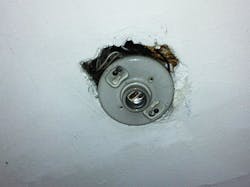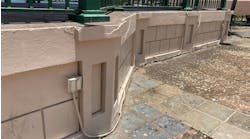How well do you know the Code? Think you can spot violations the original installer either ignored or couldn't identify? Here's your chance to moonlight as an electrical inspector and second-guess someone else's work from the safety of your living room or office. It's your turn to identify the violation.
Hint: Wide open spaces
Find the Answer
In accordance with Sec. 314.20, boxes shall be installed in walls or ceilings made of noncombustible surfaces so that the front edge of the box will not be set back more than ¼ in. from the finished surface. This box appears to be set back more than ½ in. from the ceiling surface.
Section 314.21 requires broken or incomplete noncombustible surfaces around the box to be repaired so there are no gaps or open spaces greater than 1/8 in. at the edge of the box. The giant gaps around this box are clearly wider than that dimension.
Section 314.25 states that each box must be fitted with a cover, faceplate, light fixture, or lampholder for a completed installation.
Section 410.22 also requires outlet boxes to be covered with a canopy, lampholder, or similar device. This lampholder does not do a very good job of completely covering the box.
Section 300.21 requires the openings around electrical penetrations in fire-resistant ceilings to be firestopped using approved methods to maintain the integrity of the fire-resistance rating. I believe the huge gaps around this installation could easily allow smoke and fire to spread to other areas of the building.





